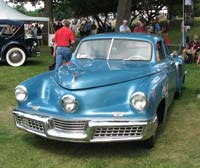












1948 Tucker |
|||
| Classic and Hot Rod Cars And Their Stories | |||
| 1948 Tucker | |||
After WWII, Studebaker was first to introduce an all new post war model, but Tucker took a different approach, designing a modern safety car with innovative features and modern styling. His specifications called for a water-cooled aluminum block flat 6 cylinder rear mounted engine, disc brakes, four wheel independent suspension, fuel injection, instruments located on the steering wheel, and padded dashboard. To finish Tuckers prototype design and start construction, Alex Tremulis previously of Auburn/Cord/Duesenberg was hired December 24, 1946, given six days to finalize the design which Tucker approved on December 31, 1946. The "Tucker Torpedo" was renamed the "Tucker '48 because of the horrors of WWII. With Tremulis' design sketch, a full page ad generated considerable public enthusiasm for the car, but the prototype was far from complete. Tucker hired New York design firm J. Gordon Lippincott to create an alternate body giving the first prototype car the nickname of "Tin Goose". The most recognizable feature was a directional third headlight, known as the "Cyclops Eye", would turn on at steering angles greater than 10 degrees lighting the car's path around corners. The car was rear-engined and rear wheel drive. A perimeter frame surrounded the vehicle for crash protection, and a roll bar integrated into the roof. The instrument panel and controls were in easy reach of the steering wheel, the dash padded for safety and seat belts, a first in its day. The parking brake had a separate key, lockable in place to prevent theft. The engine and transmission were mounted on a separate subframe which could be removed in minutes, Tucker envisioned loaner engines quickly swapped for service in just 20 minutes. Tucker initially tried to develop a 589 cubic inch (9.65L) flat 6 cylinder with hemispherical combustion chambers, fuel injection, and over head valves operated by oil pressure rather than a cam shaft. This unique engine was designed to idle at 100 RPM and cruise at 250-1200 RPM using direct drive torque converters on each driving wheel, but as engine development proceeded, problems appeared. Tucker looked for alternatives, the Franklin air-cooled 335 cid, 166 hp flat-6 helicopter engine by Air Cooled Motors fit. He purchased four and converted them to water cooling. An aircraft engine in an automobile application required significant modification, few parts of the original Franklin engine were retained. This engine was tested at maximum power for 150 hours, the equivalent of 18,000 miles at full throttle. The night before the world premiere, two of the independent suspension arms snapped under its own weight, engine problems were fixed and the car was presentable in time for the premiere. A skeptical journalist, Drew Pearson reported publicly that the car was a fraud because it had no reverse. This hurt the public view of Tucker's car at a time in history when journalists and public officials were trusted more than today. Despite this problem being limited to the first prototype, the damage was done, a negative media feeding frenzy resulted. A Borg-Warner 3 speed automatic transmission was tested and was installed on car #1048, but Tucker wanted to design his own transmission. The "Tuckermatic" was designed, strong enough to handle the Franklin O-335's power and torque. Double torque converters allowed a continuously variable drive ratio with only one forward gear and one reverse gear, it had only 27 parts, 90 fewer than normally required for an automatic. Rather than springs, Tucker used an elastomeric rubber wheel independent suspension similar to the race cars he developed with Harry Miller. The rubber elastomers were developed using a special vulcanization process to produce a specific spring rate. With the final design in place, Preston Tucker took the pre-production cars on the road to show across the country. An instant success, crowds gathered wherever they stopped. One report says Tucker was pulled over by a police officer intent on getting a better look at the car. To counteract the bad press, Tucker scheduled a two week public test at the Indianapolis Motor Speedway, one car was rolled three times at 95 mph, the driver walked away with bruises, verifying Tucker's safety features and the car was driven away from the accident after changing a tire. When the cars appear at auction, they command amazing prices. August 2008 at RM's Monterey auction for $1,017,500. Tucker #1041 sold June 7, 2009 for $750,000, the car was on the auction block 7 minutes, the owner paid $5,000 in 1970. In August 2010 at RM's Monterey auction, #1045 sold for $1,127,500 not bad for a projected sales price of $2,450! |
|||
Note: All Images And Stories On This Site Are Copywrited. Use Of Any |
|||
 Great Pricing & Selection of Cameras and Accessories: Top Camera Mall |
|||
|
|||

